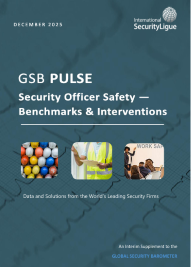
Key Points
• Beyond simplifying operations and improving security activities, integrated security solutions—that combine the unique value of people and the power of technology—can enhance overall business performance.
• Technology-enabled approaches allow richer data capture by security personnel, which case studies prove can both prevent costly mistakes while also yielding enormous—and unexpected—business value.
• Rather than thinking about security technology and business strategy separately, companies should consider them in tandem, as today’s security technology isn’t just capable of fulfilling company strategy, it can help formulate it.
Handheld Technologies Yield Eye-Opening Savings
Security technologies, including those propelled by Artificial Intelligence, are having a transformational impact on private sector security—but not only security. Indeed, in combination with human resources, security technology can do more than simplify operations and improve security activities; it can improve how businesses perform. And while the value derived from integrated security is often intentional, benefits can also come as a pleasant surprise. When security forces collect data and machines make sense of it, organizations routinely discover unseen paths to profitability.
Consider the example of one manufacturer of perishable goods, an industry where one small error causing delay can result in a spoiled shipment and a complete loss. To avoid mistakes (and their associated costs), the company worked with its security services provider to customize the handheld devices used by its frontline security personnel as they managed trucks going in and out of distribution centers and conducted patrols of warehouses. Together, they created 140 unique incident fields to better identify, track, and prevent problems, like a truck seal discrepancy, pest control issue, or identifying an incorrect trailer number at the gate, a trespasser, or a driver without proper identification.
This technology-based approach to security posts and patrols allows for richer data capture by officers and provides a fail-safe method to ensure that all required information is logged for every vehicle entering or exiting a facility. In one case recently, for example, a transportation carrier picked up the wrong truck trailer, a mistake security officers caught at the gate. If they hadn’t, in the world of perishable goods, the shipment would have been a total loss for the company.
The Food Company’s security leaders knew that catching these mistakes were helpful, but it decided to dig into data to research the financial side of incidents, so they could calculate the value of security officers’ patrols and activities. What they found was staggering.
Based on a truck’s weight, the average value of a load saved (by identifying a refrigerated truck with a temperature slightly out of allowable range, for example) was calculated to be more than $36,000 (US). By compiling such savings across all incident categories, the Food Company learned that the work of its security service provider had helped avoid more than $55 million in potential losses in one year—at a single site. And, in addition to saving money by preventing losses, the integrated security approach has helped the company reach new levels of efficiency because it now manages all activity in real time.
A 50-acre film production studio discovered similarly surprising value, when it examined the financial benefits of its security providers’ utilization of a technology platform and handheld devices that enhance the ability of security officers to report, respond to, and manage hazards quickly and effectively. For example, when officers come across water leaks on soundstages—a common occurrence—they register the incident on their device and a customized app walks them through how to manage that specific type of incident, which includes using caution tape to block off the area, taking pictures of the situation, and potentially shutting off water sources. The information immediately uploads, becoming available to security managers and the security operations center, and pictures and information about the hazard are automatically routed to the studio’s facilities department so its staff can quickly fix the problem.
Because they are now better able to identify problematic issues, times, and locations, the movie studio has engineered-out many safety risks and identifies where refresher safety training is most needed. In just one fiscal quarter, the film studio's Chief Security Officer calculated that it prevented incidents that would have totaled $657,118 (US) in direct losses.
But You Can Also Plan to Profit
When a company’s security partner utilizes innovative technology, the benefits can go beyond just making the company safer and include helping it meet strategic business objectives. The digitalization of security data, combined with analytics capabilities, permit businesses to apply information collected by a security operation to drive improvements in other areas of the business, from manufacturing and production to health and safety, quality assurance, and sales and marketing.
Security video is an obvious example. In addition to providing enhanced surveillance, intelligent video analysis can extract information from video for business value—by using people-counting or people-tracking features to improve customer service, allocate staff resources more efficiently, measure compliance, or enhance workplace safety and manufacturing efficiency by identifying process anomalies.
The value of integrated security solutions is catalyzed by the fact that “security devices” have been replaced with "information devices,” which can inform a company about many things, security breaches being just one of them. Integrated security solutions can yield data analysis to benefit any number of business functions, including by:
• helping management reallocate resources to better achieve a business objective;
• permitting a change in the management of processes to reduce the level of unplanned work or the likelihood of undesired events occurring in the future; and
• allowing new repeatable procedures to form that improve efficiency.
So, What Should Organizations Do?
With integrated security solutions expanding the value of security operations, company leaders should take an expanded view of security: Rather than thinking about security technology and business strategy separately, they should consider them in tandem.
Today’s security technology isn’t just capable of fulfilling company strategy, it can help formulate it. — Stefan Huber, Director General, International Security Ligue
Businesses can work with security partners that possess innovative technology solutions, and jointly endeavor to fully leverage those capabilities to cut expenses, improve operational efficiency, provide business intelligence, enhance safety, reduce loss, and drive business opportunity.
Security technology has become more sophisticated, more narrowly tailored, and—importantly—can now be used to stitch various parts of a business together for more holistic solutions to problems. Importantly, extracting added benefits from integrated security solutions may not require additional investment. At a Retail Council of Canada’s Loss Prevention Forum, expert panelists told company security managers that they may already hold the key to unlocking added value.
Work with your partner They might have a solution that is not part of what you currently leverage but is already part of what you use. If you can adapt it to fit a different part of the business, then you’re working smarter. — Panelist, Retail Council of Canada’s Loss Prevention Forum






